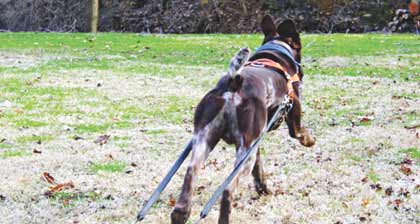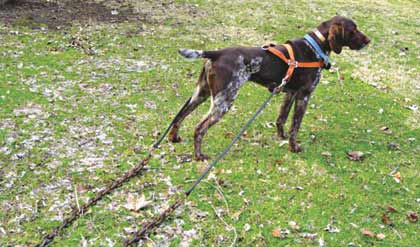Long slow distance training will prepare your dog for a full day afield.
By Bob West
 Here we can see how pulling helps develop muscle and stamina, as well as how the dog enjoys exercising. |
A dog with a solid genetic background, proper training and optimum nutrition possesses the proverbial "three-legged stool" that leads to achieving potential. Along with proper nutrition, proper conditioning enables sporting dogs to perform amazing feats. Proper nutrition and conditioning also can help minimize injuries. Our goal is not to push our dogs beyond their limit, but to condition them to perform at their peak potential.
You should set up a progressive training and conditioning plan to help build a dog's cardiovascular base. You also should prepare your dog for a variety of environmental situations, including weather and humidity.
Your plan should include a warm-up followed by resistance training and building up to long slow distance (LSD) training. Resis-tance training is an activity that helps to build muscle mass, but it is important not to build too heavy muscles that could change a dog's gait or affect its reach and drive.
LSD training helps to build a dog's cardiovascular pace by increasing endurance. Dogs train at a slower than normal pace, but they travel a longer distance than they are accustomed. Cross training, such as swimming, should be part of a training program as it helps to balance a dog's strength by conditioning muscles not used as much during their regular sport.
A trainer should ease into advanced training. During advanced training, resistance training should increase, and LSD training should decrease. Other methods used in advanced training include pace runs (exercise at or near performance intensity) and variable-speed intervals that alternate between slower and faster speeds. High-speed intervals, which can be used when a dog is fit and prepared, are fast runs that help to finish a dog's training before competition.
Recovery also is important. You want to let your dog recover by letting it relax, both mentally and physically. Throw a ball and do enjoyable things right away. Proper rest between workouts is the single most important part of recovery and is paramount to success.
For proper nutrition, adequate protein is crucial in a high-quality performance diet. Dietary protein should comprise about 24 to 40 percent of the total kilocalories (energy) and should be highly digestible. If a diet does not contain enough protein, muscle mass may be depleted, increasing the risk of soft tissue injuries, and immune function may be impaired.
Fat is the most important energy nutrient for work. Dogs fed a high fat diet can run further faster than those fed a low-fat diet. Carbohydrates are important for maximum energy output, especially when a dog is performing events over several days.
Ultimately, taking time to properly feed and condition your sporting dog is critical. Your dog is more likely to perform to its potential, and you are more likely to have an enjoyable event and very positive results€¦like a safe productive day while hunting or enduring to win an event.
The problem with finding ways to exercise your dog is that his needs quickly go beyond any program you can do together, such as going for walks. Allowing your dog to run free and exercise is a good idea but unless you're spending hours and hours at it, your dog really isn't benefiting to the extent you need to prepare him for hunting or competition. So we have to be creative in finding ways our dogs can safely work, exercise and gain endurance.
 An overall perspective of the roading harness set-up. |
One simple idea is attaching a lead to the dog's harness, allowing you to hold back, adding resistance as your dog pulls forward. Another might be using the same harness and attaching weights, like cable or chain to the harness, so that as the dog moves forward the weight drags safely alongside, causing extra resistance--i.e., more work in a given amount of time.
Some folks use chains connected to bungee cords snapped to each side of the "roading" harness, then they allow the dog to run freely through varied cover, terrain, and soil composition. The goal with this type of low level resistance is not only the advantage of working several muscle groups in one workout as the dog travels up, down and around hills and cover; there's also the advantage of varied resistance on the dragging weight. In addition, we have the added benefit of toughening pads as they are conditioned by the soil, rock, and harsh ground cover.
Many of us have seen people attach their dog's harness to a bicycle, letting the dog pull them along. This might be safe for the dog, but I wouldn't give odds on the trainer if the dog spots a distraction--say, a cat in a neighbor's yard--and makes a sudden lunge at it.
For those of you who own a four-wheeler, this is probably a safer alternative for all involved. You can set up outriggers to attach a line to the dog's harness, being sure to keep the line short enough not to allow the dog near the wheels. Using a four-wheeler allows you to apply resistance or move to LSD workouts by controlling the dog's speed in combination with the four-wheeler's speed.
Swimming is another great form of exercise, especially helpful as a low impact form of LSD work that really benefits cardiovascular systems. Most dogs will follow when you paddle ahead in a canoe, and you can easily build to whatever length of time you feel meets you dog's level of endurance. It's especially good for hot summer days, but you still have to pay close attention to overheating, especially in shallow water where surface temps are surprisingly high.
If you don't have a boat or canoe you might do repeated retrieving drills, but remember this might be a good deal more strenuous than simply swimming. Here again, be cautious of heat stress.
These ideas will be enough to get you started, but remember to keep it fun for you and the dog. Be creative and mix in training exercises to keep things in a positive productive mode. Also, as we recommended last time, before starting any exercise program get your dog in to your veterinarian for a checkup and be sure to let the vet know your plans.






